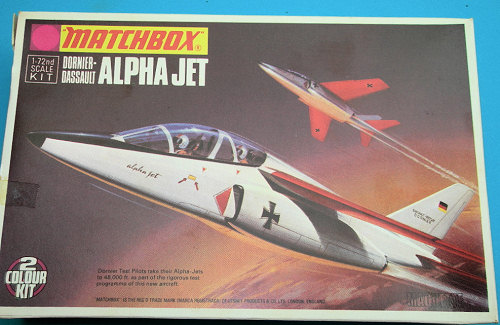
Matchbox 1/72 Dornier Alpha Jet
| KIT: | Matchbox 1/72 Dornier Alpha Jet |
| KIT #: | PK-5 |
| PRICE: | Long out of Production |
| DECALS: | Two Options |
| REVIEWER: | Victor Scheuerman |
| NOTES: | Two slightly different moldings of PK-5. Matchbox's first jet kit. |

| HISTORY |
This aircraft being built by a consortium of Dassault-Breguet-Dornier, has been designed as a Tandem 2 Seater Twin Jet Trainer and Close Support Aircraft. Prototype machines are due to fly in late 1973 and the aircraft will be used by a number of European Air Forces.
(Thanks to the kit instructions.)
The first prototype of this co-production jet first flew on October 26, 1973. France would acquire 200 as trainers and Germany would have 176 in service (50 eventually transferred to Portugal) as light attack aircraft. Production would not be limited to these numbers as Belgium (33), Egypt (45), Ivory Coast (7), Morocco (24), Nigeria (24), Qatar (6), Cameroon (7) and Togo (5) would also have them in their inventory.
| THE KIT |
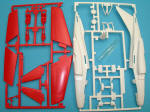 No one can say that Matchbox would
wait around for the production version of a new aircraft to be assembled before
committing themselves to a project. This kit was out so early, that this initial
boxing of PK-5 has the swept vertical tail of the full-sized static mock-up. The
later boxing would have the mold
No one can say that Matchbox would
wait around for the production version of a new aircraft to be assembled before
committing themselves to a project. This kit was out so early, that this initial
boxing of PK-5 has the swept vertical tail of the full-sized static mock-up. The
later boxing would have the mold 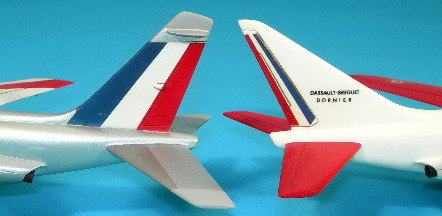 changed to better capture the look of the tail
of production version (see photograph).
changed to better capture the look of the tail
of production version (see photograph).
This kit is cleanly molded in dazzling white and red plastic as this is the basic colours of the French decal option. The 27 parts has engraved panel lines and unlike some of their later kits, these are OK. A clear one-piece canopy completes the moldings.
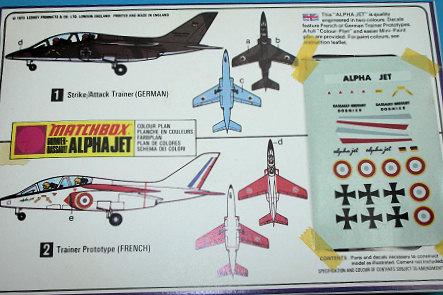 PK-5 pretty well sets the normal
Matchbox standard of a basic cockpit that in this case is two injection seats
for the well-sculptured pilots and a hint of the two instrument panels. All the
landing gear bays are framed in though the nose bay is too shallow. Another norm
is that the nose gear door should be sanded thinner or replaced with card, but
the main doors are curved and thin enough to use as offered. All the tires have
nice detail on the wheels and the kits legs are fine if perhaps a little chunky.
PK-5 pretty well sets the normal
Matchbox standard of a basic cockpit that in this case is two injection seats
for the well-sculptured pilots and a hint of the two instrument panels. All the
landing gear bays are framed in though the nose bay is too shallow. Another norm
is that the nose gear door should be sanded thinner or replaced with card, but
the main doors are curved and thin enough to use as offered. All the tires have
nice detail on the wheels and the kits legs are fine if perhaps a little chunky.
The fuselage is made up of the two halves with separate intakes, engine outlets and radome. All the flying surfaces have thin trailing edges, but total lacking are the pronounced lower wing fairings seen on the flying versions. No stores are offered in this kit.
Assembly is covered in five well illustrated steps and the detail colour notes are offered separately at the end of the instructions. Two decal options are included with a French Trainer Prototype with a white fuselage and red wings, while the camouflaged German Strike/Trainer boasts only basic national insignia. The yellow outlines to the French roundels are slightly off-register but otherwise the decals look useable. Both of these schemes are shown in full colour on the back of the box.
| CONCLUSIONS |
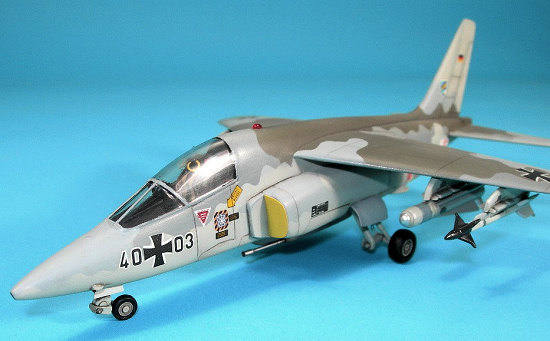 While some my lament that this is a
model of the static mock-up, I think that is its strongest point. I do like
modeling the odd prototype and what-if (see single seat build) if one wishes to
represent the entire Alpha family, then this kit would be a great place to
start; but I would probably use the Fujimi kit for the remainder…
While some my lament that this is a
model of the static mock-up, I think that is its strongest point. I do like
modeling the odd prototype and what-if (see single seat build) if one wishes to
represent the entire Alpha family, then this kit would be a great place to
start; but I would probably use the Fujimi kit for the remainder…
| REFERENCES |
The Encyclopedia of World Aircraft, David Donald, Prospero Books
December 2007
If you would like your product reviewed fairly and quickly, please contact me or see other details in the Note to Contributors.